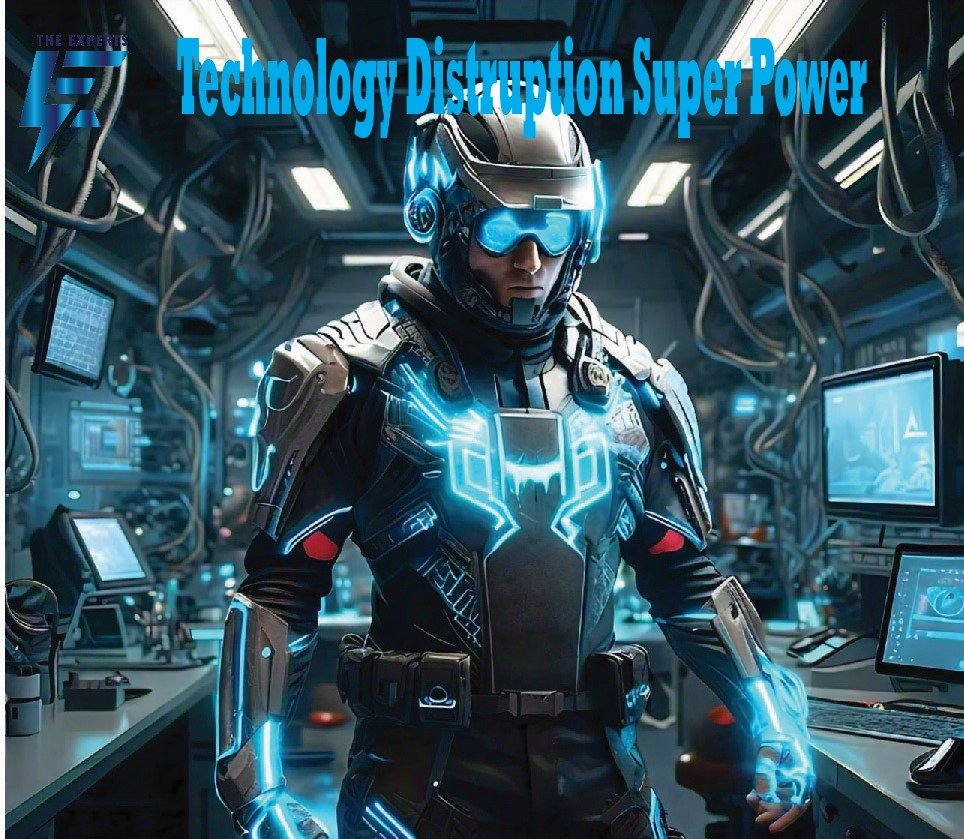Introduction
Crescendo Ing globalization coupled with rapid technological advancement characterizes the 21st century. Out of which, technology distruption super power is serving as a prominent phenomenon directing industries, economies, and even societies. Disruption occurs when new inventions radically change the existing order and how businesses are run or how consumers interact with their products and services.
In fact, its essence can be compared to a “superpower” – an exceptional power endowed to anyone, and if used properly, endless development, creativity, and surplus for humanity will be experienced. Thus, appreciating technology disruption is vital to all individuals, organizations, and state machineries in this turbulent period.
The Nature of Technology Disruption
Historical Context
The introduction of new technologies has, over the years, resulted in social shifts. The era of the Industrial Revolution brought forth a new economic order as societies transformed from agrarian to urban based economies in the industries, thus transforming Labor and production extensively. In the same way, the Ba of the Internet changed the way we communicated, the way business transactions were done, and the way people accessed information in a very large scale.
Key Historical Examples of Disruption
| Year | Technology | Impact |
|---|---|---|
| 1760-1840 | Steam Engine | Revolutionized transportation and industry |
| 1990s | Internet | Redefined communication and business models |
| 2000s | Smartphones | Changed social interactions and access to information |
| 2010s | AI and Machine Learning | Enhanced automation and data analytics |
Characteristics of Disruptive Technologies
The following characteristics of technology explain why it brings about such drastic changes to the industry:
- Innovation and Improvement: Provided that most innovations incorporate existing technological components, disruptive technologies usually dramatically outperform the existing alternatives — in speed, efficiency or price.
- Market Transformation: These technologies are able to introduce new markets or change the existing one, creating a different aspect of demand and changing the customers’ behaviours.
- Societal Impact: The impact of the disruption is not limited to businesses, but rather affects social paradigms, employment systems, and even institutional practices
The Impact of Technology Disruption
Economic Implications
The disruptive nature of technology has economic implications that cut across sectors. On the one hand, disruption creates new industries, which may engender jobs in areas where such industries previously did not exist. The expansion of the Internet and its features, on the other hand, has given rise to occupations like logistics, data analysis, and web-based marketing. Still, the other side of this coin is the potential threat of unemployment, particularly in the case of conservative industries with older mindsets and workforce.
Job Market Dynamics
| Industry | Impact of Disruption | Job Creation/Destruction |
|---|---|---|
| Retail | Shift to online shopping | + E-commerce roles |
| Transportation | Rise of ride-sharing services | – Taxi driver jobs |
| Manufacturing | Automation and smart factories | + Tech and maintenance jobs |
| Healthcare | Telemedicine and health tech | + Telehealth specialists |
Social Consequences
Consumer behaviour and social order can also be upended by disruption. The advances in technology have made it easier for the consumer to get faster and better service. One can particularly see this in industries like that of s, where innovations have made viewing no longer dependent on cable subscriptions as streaming technology has made them obsolete.
In addition, disruption may engender a division in the experiences of certain groups, whereby some groups gain and optimistic experiences while the opposition historically feels disgruntled. The digital gap continues to act as a barrier for some people, affecting issues of education, employment, and general standards of living due to lack of access to technology and the Internet.
Access and Inclusivity
With the advancement of technology, there should be no discrimination as it should be a benefit to every person across the world. However, we have observed that one’s access to the latest technologically advanced gears and equipment exorbitantly depends on their region, social class, and educational attainment. We need to correct this impression so that no individual is excluded from the digital economy.
Global Perspectives
The impacts of technology distruption super power differ with regard to more and less developed countries. For instance, developed nations have the capability to exploit the disruption for boosting productivity and growth in innovations but for low-income or developing countries, it may be a challenge due to a number of factors such as limited access to technology and infrastructure.
Case Study
Mobile Banking in Developing Countries
In several emerging economies, for example, mobile money services have become quite popular and are driving the unbanked majority into the financial services sector. With little or no access to brick-and-mortar banks, hundreds of millions have registered for mobile money services to facilitate remittances, savings and loans. Such disruptive technology does not simply encourage users’ economic participation but also enriches them in the process.
Environmental Considerations
The last thing worth considering is the scope of technological disruption without its environmental implications. For the very reason of the evolution of different industries, the higher demand for sustainable operations is needed. The example of a disruptive technology in the automotive industry is the introduction of electric vehicles, which helps in combating global warming and redefining motoring as an activity. Enterprises that focus on developing environmentally friendly technologies can remain competitive even as sustainability becomes increasingly important in today’s changing times.
Harnessing Technology Distruption Super power
Strategies for Individuals and Businesses
Achieving the positive end of the technologies that disrupt the status quo as a superpower requires time and strategies both on the part of the individuals and organizations in question:
- Embracing Innovation: Workers and the organization must enhance innovativeness and encourage all employees to actively pursue new ideas and technologies.
- Adapting to Change: There is a need for businesses to be dynamic in that they should be capable of altering their strategic focus in accordance with the technology available at that particular time. This is achievable through the use of learning and development strategies.
- Continuous Learning: Active voice: Each individual should cultivate the habit of continuously improving and acquiring new skills in line with the latest technology. You can gain this knowledge through e-learning, attending seminars, and conferences.
- Networking and Collaboration: Having strong relationships makes it easy to interact and exchange ideas and thoughts, keeping any organization or individual within the ranks.
Government and Policy Responses
The Government’s role is important in containing the disruptive effects of technology. Such policies should regulate the protection of a given class of people, their consumers, and workers, while allowing businesses to conduct their affairs freely without unwarranted meddlesomeness.
Regulation vs. Innovation
It is also pertinent to build infrastructures that encourage creativity and at the same time promote moral standards. For example, artificial intelligence should be at the same level as the law on data privacy to prevent theft. However, these technologies also connect the introduction of robots and AI systems in every sector requiring human labor.
Future Outlook
History shrouds the future with ambiguity, allowing room for more upheavals to occur. Disruptive technologies like quantum computing, biotechnology and even blockchain are just about to come with promises that will disrupt the whole industries once again.
- Quantum Computing: Advances in artificial intelligence appear to provide understanding enabling new tools, processes, & systems that can rapidly address problems occurring within various disciplines such as drug development, financial services and so on.
- Biotechnology: Genetic engineering and synthetic biology may change how we practice agriculture, healthcare, and environmental sustainability in the near future. These concepts and fundamental advances will play a crucial role in shaping the future of these industries.
Blockchain
Unlike virtual money, blockchain technology enables businesses to conduct transactions, monitor supply chains, and verify people’s identity.
Stakeholders in the industry should be prepared for scans and proactive actions. Enterprises should allocate resources for innovation as regards the application of these technologies in their business processes, while states should promote a risk-taking attitude towards science and technology.
Challenges and Ethical Considerations
In one way or another, the positive effects of technology disruption outnumbers the negative lessons learned.
Potential Drawbacks
- Inequality and Access Issues: Disruption may worsen the situation of those already disadvantaged. Members of such groups who do not have access to technology may become even more isolated.
- Job Displacement: Such automation can easily lead to massive unemployment even for the unskilled performing tasks, further worsening the situation. To deal with such concerns there must be an effort from both sides of the economy the government and private all retraining the displaced workers.
- Data Privacy and Security: As data becomes a more and more central component of modern-day businesses and their operations, concerns about privacy and security have become important issues. Businesses must develop and implement ethical standards regarding the use of consumer data in order to preserve their markets and abide with the law.
The Role of Corporate Responsibility
Organizations should embrace corporate social responsibility as a key strategy and ensure that innovation strategies do not cause negative externalities. For instance, this includes corporate spending on retraining of their workforces and on communities that have suffered disruption. Additionally, such organizations ought to conduct outreach or advocacy campaigns for support from relevant stakeholders to build support and trust.
Conclusion
The digitization of industries without proper control changes the dynamics of the market, resulting in what can be perceived as unreasonable energy. In order to capitalize on this energy, people, organizations and governments would have to cooperate and become responsible change agents. Through the acceptance of new ideas, willingness to change and above all ethical considerations, one can manage to turn technology disruption into a positive development and consequently create a better world for everyone.
When we contemplate the future, one aspect stands out: appreciation of and participation in disruption is no longer an indulgence, but a prerequisite for existence in the controlled chaos that is the 21st century. In that way, we turn the negative effects of technology distruption super power into its positive effects, hence enabling us to utilize technology as the power that it was designed to be.
For the persons, organizations, and countries in the future, the ability to deal with and even exploit technological upheaval will determine success. Enabling such a superpower will not only encourage feelings of healthy competition among citizens but will also enrich everyone with innovation and creativity thereby bridging the social gaps.
Read More about Technology Trends On The Experts Tech.

